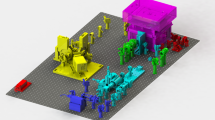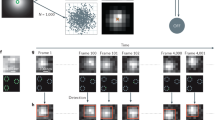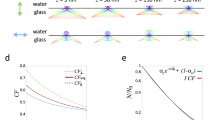Abstract
Single-molecule localization microscopy enables three-dimensional fluorescence imaging at tens-of-nanometer resolution, but requires many camera frames to reconstruct a super-resolved image. This limits the typical throughput to tens of cells per day. While frame rates can now be increased by over an order of magnitude, the large data volumes become limiting in existing workflows. Here we present an integrated acquisition and analysis platform leveraging microscopy-specific data compression, distributed storage and distributed analysis to enable an acquisition and analysis throughput of 10,000 cells per day. The platform facilitates graphically reconfigurable analyses to be automatically initiated from the microscope during acquisition and remotely executed, and can even feed back and queue new acquisition tasks on the microscope. We demonstrate the utility of this framework by imaging hundreds of cells per well in multi-well sample formats. Our platform, implemented within the PYthon-Microscopy Environment (PYME), is easily configurable to control custom microscopes, and includes a plugin framework for user-defined extensions.
This is a preview of subscription content, access via your institution
Access options
Access Nature and 54 other Nature Portfolio journals
Get Nature+, our best-value online-access subscription
$29.99 / 30 days
cancel any time
Subscribe to this journal
Receive 12 print issues and online access
$209.00 per year
only $17.42 per issue
Buy this article
- Purchase on Springer Link
- Instant access to full article PDF
Prices may be subject to local taxes which are calculated during checkout





Similar content being viewed by others
Data availability
The 3D localizations, calibration files and raw blinking videos for all series in Fig. 2, and Cell no. 1, no. 2,504, no. 5,735, no. 8,041, no. 9,577 and no. 11,160 from the lamin-NPM1 dataset in Fig. 4 (and 3D localizations for the remaining cells), are publicly available through the 4D Nucleome data portal at https://data.4dnucleome.org/publications/7d9fad19-54c4-419e-8d99-8157f5c1904b/. Any additional data from this work can be obtained through the authors upon request.
Code availability
The code for automated acquisition, distributed data storage and analysis is released under the GNU General Public License v.3 as part of the python-microscopy project and is available at github.com/python-microscopy/python-microscopy. The quantized compression software can be installed independently, with instructions for use with third-party software additionally available at github.com/python-microscopy/pymecompress. Code for GPU acceleration of single-molecule fitting is available under an academic use license from github.com/barentine/pyme-warp-drive. The LabVIEW acquisition software used in phase 1 can be obtained from the authors; however, it is not actively maintained. Please contact the authors for alternative licensing arrangements.
References
Baddeley, D. & Bewersdorf, J. Biological insight from super-resolution microscopy: what we can learn from localization-based images. Annu. Rev. Biochem. 87, 965–989 (2018).
Xu, K., Zhong, G. & Zhuang, X. Actin, spectrin, and associated proteins form a periodic cytoskeletal structure in axons. Science 339, 452–456 (2013).
Szymborska, A. et al. Nuclear pore scaffold structure analyzed by super-resolution microscopy and particle averaging. Science 341, 655–658 (2013).
Zhang, Y., Lara-Tejero, M., Bewersdorf, J. & Galán, J. E. Visualization and characterization of individual type III protein secretion machines in live bacteria. Proc. Nat Acad. Sci. USA 114, 6098–6103 (2017).
Yuan, P. et al. Trem2 haplodeficiency in mice and humans impairs the microglia barrier function leading to decreased amyloid compaction and severe axonal dystrophy. Neuron 90, 724–739 (2016).
Boettiger, A. N. et al. Super-resolution imaging reveals distinct chromatin folding for different epigenetic states. Nature 529, 418–422 (2016).
Mund, M. et al. Systematic nanoscale analysis of endocytosis links efficient vesicle formation to patterned actin nucleation. Cell 174, 884–896.e17 (2018).
Beghin, A. et al. Localization-based super-resolution imaging meets high-content screening. Nat. Methods 14, 1184–1190 (2017).
Holden, S. J. et al. High throughput 3D super-resolution microscopy reveals Caulobacter crescentus in vivo Z-ring organization. Proc. Natl Acad. Sci. USA 111, 4566–4571 (2014).
Huang, F. et al. Video-rate nanoscopy using sCMOS camera-specific single-molecule localization algorithms. Nat. Methods 10, 653–658 (2013).
Lin, Y. et al. Quantifying and optimizing single-molecule switching nanoscopy at high speeds. PLoS ONE 10, e0128135 (2015).
Diekmann, R. et al. Optimizing imaging speed and excitation intensity for single-molecule localization microscopy. Nat. Methods 17, 909–912 (2020).
Shim, S.-H. et al. Super-resolution fluorescence imaging of organelles in live cells with photoswitchable membrane probes. Proc. Natl Acad. Sci. USA 109, 13978–13983 (2012).
Marin, Z. et al. PYMEVisualize: an open-source tool for exploring 3D super-resolution data. Nat. Methods 18, 582–584 (2021).
Juette, M. F. et al. Three-dimensional sub-100 nm resolution fluorescence microscopy of thick samples. Nat. Methods 5, 527–529 (2008).
Olivier, N., Keller, D., Gönczy, P. & Manley, S. Resolution doubling in 3D-STORM imaging through improved buffers. PLoS ONE 8, 1–9 (2013).
Huang, B., Wang, W., Bates, M. & Zhuang, X. Three-dimensional super-resolution imaging by stochastic optical reconstruction microscopy. Science 319, 810–813 (2008).
Thompson, R. E., Larson, D. R. & Webb, W. W. Precise nanometer localization analysis for individual fluorescent probes. Biophys. J. 82, 2775–2783 (2002).
Lin, R., Clowsley, A. H., Jayasinghe, I. D., Baddeley, D. & Soeller, C. Algorithmic corrections for localization microscopy with sCMOS cameras—characterisation of a computationally efficient localization approach. Opt. Express 25, 11701 (2017).
Smith, C. S., Joseph, N., Rieger, B. & Lidke, K. A. Fast, single-molecule localization that achieves theoretically minimum uncertainty. Nat. Methods 7, 373–375 (2010).
Staněk, D. & Neugebauer, K. M. Detection of snRNP assembly intermediates in Cajal bodies by fluorescence resonance energy transfer. J. Cell Biol. 166, 1015–1025 (2004).
Machyna, M. et al. The coilin interactome identifies hundreds of small noncoding RNAs that traffic through Cajal bodies. Mol. Cell 56, 389–399 (2014).
Boulon, S., Westman, B. J., Hutten, S., Boisvert, F. M. & Lamond, A. I. The nucleolus under stress. Mol. Cell 40, 216–227 (2010).
Mazidi, H., Ding, T., Nehorai, A. & Lew, M. D. Measuring localization confidence for quantifying accuracy and heterogeneity in single-molecule super-resolution microscopy. In Proc. SPIE 11246, Single Molecule Spectroscopy and Superresolution Imaging XIII (eds Gregor, I. et al.) 1124611 (SPIE, 2020).
Culley, S. et al. Quantitative mapping and minimization of super-resolution optical imaging artifacts. Nat. Methods 15, 263–266 (2018).
Marsh, R. J. et al. Sub-diffraction error mapping for localisation microscopy images. Nat. Commun. 12, 1–13 (2021).
Štefko, M., Ottino, B., Douglass, K. M. & Manley, S. Autonomous illumination control for localization microscopy. Opt. Express 26, 30882 (2018).
Babcock, H., Sigal, Y. M. & Zhuang, X. A high-density 3D localization algorithm for stochastic optical reconstruction microscopy. Opt. Nanoscopy 1, 6 (2012).
Speiser, A. et al. Deep learning enables fast and dense single-molecule localization with high accuracy. Nat. Methods 18, 1082–1090 (2021).
Ouyang, W., Aristov, A., Lelek, M., Hao, X. & Zimmer, C. Deep learning massively accelerates super-resolution localization microscopy. Nat. Biotechnol. 36, 460–468 (2018).
Hartwich, T. M. et al. A stable, high refractive index, switching buffer for super-resolution imaging. Preprint at bioRxiv https://www.biorxiv.org/content/10.1101/465492v1 (2018).
Huffman, D. A. A method for the construction of minimum-redundancy codes. Proc. IRE 40, 1098–1101 (1952).
Balazs, B., Deschamps, J., Albert, M., Ries, J. & Hufnagel, L. A real-time compression library for microscopy images. Preprint at bioRxiv https://www.biorxiv.org/content/10.1101/164624v1 (2017).
Pedregosa, F. et al. Scikit-learn: machine learning in Python. J. Mach. Learn. Res. 12, 2825–2830 (2011).
Acknowledgements
We thank A. Wrogg for contributing the timeline in Fig. 1. We thank L. Schroeder and Y. Zhang for helpful discussions and technical assistance. This work was primarily supported by a 4D Nucleome grant from the National Institutes of Health (NIH) (grant no. U01 DA047734 to J.B. and D.B.). J.B. acknowledges support from NIH grant no. P30 DK045735 (to R. Sherwin). A.E.S.B. acknowledges support by an NIH training grant (no. T32 GM008283) and training on the Computational Image Analysis in Cellular and Developmental Biology Course of the Marine Biology Laboratory (which was supported by NIH grant no. R25 GM103792). We are also grateful for funding from NIH awards no. U01CA200147 TCPA-2017-Neugebauer and OPAS (to K.M.N.) and no. 1R01NS128358-1 (to K.M.N. and J.B.). This work is solely the responsibility of the authors and does not necessarily represent the official views of the NIH.
Author information
Authors and Affiliations
Contributions
Y.L. and J.B. designed the optical hardware of the microscope which Y.L. built. A.E.S.B., Y.L., D.B., Z.M., T.P. and J.R.C. developed acquisition control software. M.R.G., A.E.S.B. and D.B. designed and implemented the computer cluster. D.B. designed the distributed the storage architecture and compression algorithm. D.B. and L.B. designed and implemented the cluster task distribution. A.E.S.B. and D.B. developed the GPU acceleration code. S.W. and M. Liu designed the FISH probes. E.M.C., P.K., M. Lessard, F.R.-M., M. Liu, S.W. and K.M.N. optimized sample preparation protocols and prepared samples. A.E.S.B., Y.L. and E.M.C. performed imaging experiments. A.E.S.B., Y.L. and D.B. performed post-localization analysis. All authors contributed to writing the manuscript.
Corresponding authors
Ethics declarations
Competing interests
J.B. discloses a financial interest in Bruker Corp. and Hamamatsu Photonics. All other authors declare no competing interests.
Peer review
Peer review information
Nature Biotechnology thanks Bogdan Bintu and the other, anonymous, reviewer(s) for their contribution to the peer review of this work.
Additional information
Publisher’s note Springer Nature remains neutral with regard to jurisdictional claims in published maps and institutional affiliations.
Supplementary information
Supplementary Information
Supplementary Figs. 1–10, Notes 1–8 and Tables 1–4.
Video showing a reconstruction of each of the 11,145 nuclei contributing to Fig. 4.
Video showing an automated acquisition using simulated hardware in PYMEAcquire with a ‘cluster of one’ for automated localization and recipe-based analysis.
Supplementary Table 5
LAD probe design including sequences of PCR primers, reverse transcription primers and activator oligos. The worksheet lists the sequences of the forward and reverse PCR primers and the reverse transcription primers used in the synthesis of each LAD probe library. The /5Alex647N/ in the sequences indicates 5′ Alexa Fluor 647 modifications of the DNA oligos.
Supplementary Table 6
Template sequences for LAD probe library syntheses. All oligonulceotide sequences in each template LAD probe library are compiled as a list. Different LAD libraries are placed in different worksheets labeled with the names of the LADs that the libraries target.
Supplementary Table 7
TAD probe design information including sequences of PCR primers and reverse transcription primers. The worksheet lists the sequences of the forward and reverse PCR primers and the reverse transcription primers used in the synthesis of the Chr22 probe library. The /5Biosg/ in the sequence indicates 5′ biotin modifications of the DNA oligos.
Supplementary Table 8
Template sequences for TAD probe library syntheses. All oligonulceotide sequences in each template LAD probe library are compiled as a list. Different LAD libraries are placed in different worksheets labeled with the names of the LADs that the libraries target.
Rights and permissions
Springer Nature or its licensor (e.g. a society or other partner) holds exclusive rights to this article under a publishing agreement with the author(s) or other rightsholder(s); author self-archiving of the accepted manuscript version of this article is solely governed by the terms of such publishing agreement and applicable law.
About this article
Cite this article
Barentine, A.E.S., Lin, Y., Courvan, E.M. et al. An integrated platform for high-throughput nanoscopy. Nat Biotechnol 41, 1549–1556 (2023). https://doi.org/10.1038/s41587-023-01702-1
Received:
Accepted:
Published:
Issue Date:
DOI: https://doi.org/10.1038/s41587-023-01702-1
This article is cited by
-
Smart lattice light-sheet microscopy for imaging rare and complex cellular events
Nature Methods (2024)
-
DBlink: dynamic localization microscopy in super spatiotemporal resolution via deep learning
Nature Methods (2023)



